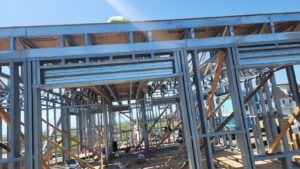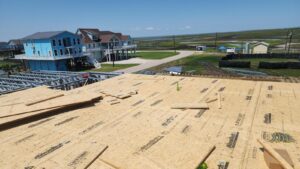Cold Form Steel vs Wood
Why is Cold Form Steel (CFS) the future of building?
Why is it a better option than wood?
Does your location have environmental challenges, like hurricanes, earthquakes, fire, termites, heavy snow loads, Mold and other challenges and you are looking for a solutions?
At Well Done 1 we have the Solution and ECO BENEFITS
Our Full Home Kit not only provides a comprehensive solution for your construction needs but also reflects our commitment to eco-friendly living. Here’s why our kits stand out:
Our building system is designed for DIY and unskilled workers, making it a simple construction experience with a superior framing option for the inner strength of your home or project.
Termite, Mold, and Pest Resistance
Designed to resist termites, mold, rodents, and bugs, ensuring the longevity of your home without structural damage worries caused by these common issues.
Fire-Resistant
Safety is paramount. Our steel stud frames are fire-resistant, providing an additional layer of security for you and your family. Durable and Reliable: With these features, your home is not just a shelter; it’s a durable, reliable sanctuary that withstands the test of time. With 5.5’ exterior walls and it can be engineered to handle over 200mph winds and heavy snow loads
Energy Efficiency
allows for effective insulation, contributing to energy-efficient buildings and reduced utility costs
Sustainable Choice
By selecting Well done 1 Home Kits, you’re making an eco-conscious decision. Our sustainable construction methods contribute to a greener environment, reducing your carbon footprint. Energy efficient and lower maintenance and insurance costs
Customized to Your Needs
Each kit is meticulously tailored to meet your location’s building codes and zoning requirements. Our frames are engineered to endure various challenges such as snow loads, hurricanes, seismic activities, and other environmental factors specific to your area. Save 50% of time in construction, no welding, Simple and easy as, screw the panel sections together, predrilled holes for electrical and plumbing, done for you.
Insurance Industry Recognition
Some insurance providers recognize the benefits of steel construction in terms of safety and durability. Non-combustible materials like steel may be viewed favorably by insurers, potentially leading to lower insurance premiums.
Consistency and Predictability
The manufacturing process of cold-formed steel allows for precise and consistent production, resulting in materials with predictable performance. This predictability can lead to more accurate assessments of risks and, in turn, may influence insurance costs.
Stability and Consistency: Cold-formed steel is manufactured with precision, resulting in consistent and stable building materials. This uniformity reduces the likelihood of structural shifts, warping, or settling over time, which can contribute to long-term stability and lower maintenance requirements.
Minimal Expansion and Contraction: Unlike some materials that may expand or contract significantly with temperature changes, cold-formed steel exhibits minimal thermal movement. This characteristic reduces stress on the building structure and minimizes the likelihood of cracks or damage over time.
Resistance to Pests and Insects: Cold-formed steel is not susceptible to pest infestations, such as termites, which can be a common issue with wood. The resistance to pests eliminates the need for ongoing pest control measures, reducing maintenance costs.
What is the difference between steel stud framing structures and wood framing?
Steel stud framing and wood framing are both common methods of building the structural frame of a building. However, there are some key differences between the two.
- Strength and durability: Steel studs are stronger and more durable than wood studs. They are less likely to warp, twist, or rot, and they can hold more weight.
- Fire resistance: Steel studs have a higher fire resistance than wood studs. Steel will not burn, and it does not contribute to the spread of a fire.
- Pest resistance: Steel is not attractive to pests such as termites and carpenter ants, which can cause damage to wood frames.
- Cost: Steel studs are typically slightly more expensive than wood studs but you saving in reduced labor costs and reduced cycle time for project making the steel stud frame less expensive, typically the framing time is reduced by 2/3 of time .
- Environmental Impact: steel is not a renewable resource, and its production has a bigger carbon footprint than wood.
- Installation: Steel studs are assembled in Panelized sections and more precise cutting, and true and straight and quicker to assemble on site reducing project cycles , and the rest of the construction process is the same as wood. Except wood uses nails and steel stud structures use self tapping screws , to attach structural sheathing and drywall , When it comes to windows and doors the rough openings in steel stud structures are more precise and true , making it easier to install windows and doors.
- Steel Stud Frames have pre drilled holes in the studs saving, time for the electrician and plumber , snap in Bushings can be purchased in bulk from the home depot
- There is no welding required for CFS, as residential is different to commercial.
Overall, steel stud framing is generally considered to be more durable and fire-resistant than wood framing.
What is cold-formed steel framing?
Cold-formed steel framing is a construction method in which steel members are formed into various shapes (such as C-sections, U-sections, and L-shaped angles) at room temperature, rather than being heated and then shaped as in hot-rolled steel.
These steel members are then used as the structural framing for buildings and other structures. Cold-formed steel framing is known for its strength, durability, and ease of installation, and it is a popular choice for both residential and commercial construction.
The use of this framing system can result in significant weight reduction of the building structure and allows for greater design flexibility. It also offers good resistance to natural hazards such as earthquakes and high winds.
Steel stud framing offers several benefits in construction, such as:
- High strength-to-weight ratio: Steel studs are strong yet lightweight, allowing for the creation of strong, stable structures without adding unnecessary weight.
- Cost-effective: Steel studs are less expensive than traditional wood framing methods, and they do not require additional costs for fireproofing or other safety measures.
- Durability: Steel is resistant to fire, rot, insects, and other hazards, making it a durable choice for construction.
- Easy to work with: Steel studs are easy to cut, bend, and shape, making them easy to work with for builders and contractors.
- Versatile: Steel studs can be used for a variety of different construction projects, including residential, commercial, and industrial buildings.
- Environmentally friendly: Steel is a recyclable material, and it saves wood, which is a valuable natural resource.
- Precision: Steel studs can be produced to tight tolerances, enabling precise and accurate construction.
- Speed of construction: Steel studs are lightweight and easy to handle, meaning that they can be installed faster than traditional wood framing methods.
Is the main difference between traditional built homes and steel stud frames homes the structure building skeleton known as the framing of any residential home?
Yes, the main difference between traditional built homes and steel stud framed homes is the structure. Traditional homes are typically constructed using more traditional materials such as wood, brick, and stone. These materials are used to create the load-bearing structure of the building, such as the walls and floors.
On the other hand, steel stud framed homes are constructed using cold-formed steel as the primary structural material. The steel studs are used to create the load-bearing walls and floor/roof framing.
Aside from the structure, there are also other differences between traditional built homes and steel stud framed homes such as fire resistance, pest resistance, cost, environmental impact, and ease of installation. Traditional homes are generally considered to be more customizable, while steel stud framed homes offer greater strength, durability, and fire resistance.
Cold Form Steal (CFS) vs Wood FAQ's
Cold-formed steel (CFS) has several benefits over wood when it comes to construction:
- Strength and durability: CFS is stronger and more durable than wood, and it can withstand higher loads and resist warping, twisting, and cracking.
- Fire resistance: CFS has a higher fire resistance rating than wood, which can provide added protection in case of fire.
- Pest resistance: CFS is not susceptible to damage from pests such as termites and carpenter ants, which can be a major problem with wood structures.
- Longevity: CFS has a longer lifespan than wood, and it requires less maintenance over time.
- Design flexibility: CFS can be formed into a wide variety of shapes and sizes, which allows for greater design flexibility and can result in weight reduction of the building structure.
- Speed of installation: CFS framing is light weight and easy to handle, which speeds up the installation process and reduces labor costs.
- Energy efficiency: Cold-formed steel framing is thermally efficient, it has a low thermal mass, which means it absorbs and releases heat quickly. This results in lower heating and cooling costs for the building.
- Sustainability: CFS is a recyclable material, it can be recycled at the end of its life, it is also known for its ability to be made from recycled steel.
It's worth noting that, while CFS has many benefits over wood, each material has its own advantages, and the choice between them will depend on the specific project and the requirements of the building.
The cost difference between wood and cold-formed steel (CFS) can vary depending on several factors such as the location, the complexity of the project, the size and type of the building, and the cost of materials and labor.
Generally speaking, CFS is typically the same as wood when it comes to initial costs. However, over the life of a building, CFS is often less expensive than wood due to its longevity and lower maintenance costs and lower insurance costs.
The cost of the materials for CFS is slighty higher than wood, but it can be offset by the lower labor costs for installation. CFS is lightweight and easy to handle, which speeds up the installation process and reduces labor costs.
In addition, CFS framing is thermally efficient, which means it absorbs and releases heat quickly, this results in lower heating and cooling costs for the building.
CFS also offers greater design flexibility, which can result in weight reduction of the building structure and it also provides better resistance to natural hazards such as earthquakes and high winds.
The cost of CFS and wood can vary depending on the region, the availability of materials, and the cost of labor. Therefore, it's important to consider all factors and consult with a professional to determine the most cost-effective solution for a specific project.
- Strength and durability: Cold-formed steel (CFS) is stronger and more durable than other framing materials, and it can withstand higher loads and resist warping, twisting, and cracking.
- Fire resistance: CFS has a higher fire resistance rating than other materials, which can provide added protection in case of fire.
- Pest resistance: CFS is not susceptible to damage from pests such as termites and carpenter ants, which can be a major problem with wood structures.
- Longevity: CFS has a longer lifespan than other materials, and it requires less maintenance over time.
- Design flexibility: CFS can be formed into a wide variety of shapes and sizes, which allows for greater design flexibility and can result in weight reduction of the building structure.
- Speed of installation: CFS framing is lightweight and easy to handle, which speeds up the installation process and reduces labor costs.
- Energy efficiency: CFS is thermally efficient, it has a low thermal mass, which means it absorbs and releases heat quickly. This results in lower heating and cooling costs for the building.
- Sustainability: CFS is a recyclable material, it can be recycled at the end of its life, it is also known for its ability to be made from recycled steel.
- Resistance to natural hazards: CFS offers good resistance to natural hazards such as earthquakes and high winds.
- Cost-effectiveness: CFS is typically more expensive than other materials when it comes to initial costs. However, over the life of a building, CFS is often less expensive than other materials due to its longevity and lower maintenance costs.
Cold-formed steel (CFS) joists and wood joists are both used for supporting the floors and roofs in construction. However, there are several key differences between the two materials:
- Strength and durability: CFS joists are stronger and more durable than wood joists and are less likely to warp, twist, or crack. CFS joists are also more resistant to fire and pests.
- Longevity: CFS joists have a longer lifespan than wood joists, and they require less maintenance over time.
- Design flexibility: CFS joists can be formed into a wide variety of shapes and sizes, which allows for greater design flexibility and can result in weight reduction of the building structure.
- Speed of installation: CFS joists are lightweight and easy to handle, which speeds up the installation process and reduces labor costs.
- Energy efficiency: CFS joists are thermally efficient, they have a low thermal mass, which means they absorb and release heat quickly. This results in lower heating and cooling costs for the building.
- Sustainability: CFS joists are made of recycled steel and can be recycled again at the end of their life.
- Consistency: CFS joists are consistent in their quality, strength and size, this makes them ideal for use in multi-unit buildings and other structures where uniformity is important.
- Cost: CFS joists are typically more expensive than wood joists when it comes to initial costs. However, over the life of a building, CFS joists are often less expensive than wood joists due to their longevity and lower maintenance costs.
It's worth noting that, both CFS joists and wood joists have their own advantages and disadvantages, and the choice between them will depend on the specific project and the requirements of the building.
Cold-formed steel (CFS) roof trusses and wood trusses are both used for supporting the roofs in construction, but there are several key differences between the two materials:
- Strength and durability: CFS roof trusses are stronger and more durable than wood trusses and are less likely to warp, twist, or crack. CFS roof trusses are also more resistant to fire and pests.
- Longevity: CFS roof trusses have a longer lifespan than wood trusses, and they require less maintenance over time.
- Design flexibility: CFS roof trusses can be formed into a wide variety of shapes and sizes, which allows for greater design flexibility and can result in weight reduction of the building structure.
- Speed of installation: CFS roof trusses are lightweight and easy to handle, which speeds up the installation process and reduces labor costs.
- Energy efficiency: CFS roof trusses are thermally efficient, they have a low thermal mass, which means they absorb and release heat quickly. This results in lower heating and cooling costs for the building.
- Sustainability: CFS roof trusses are made of recycled steel and can be recycled again at the end of their life.
- Consistency: CFS roof trusses are consistent in their quality, strength and size, this makes them ideal for use in multi-unit buildings and other structures where uniformity is important.
- Cost: CFS roof trusses are typically more expensive than wood trusses when it comes to initial costs. However, over the life of a building, CFS roof trusses are often less expensive than wood trusses
















